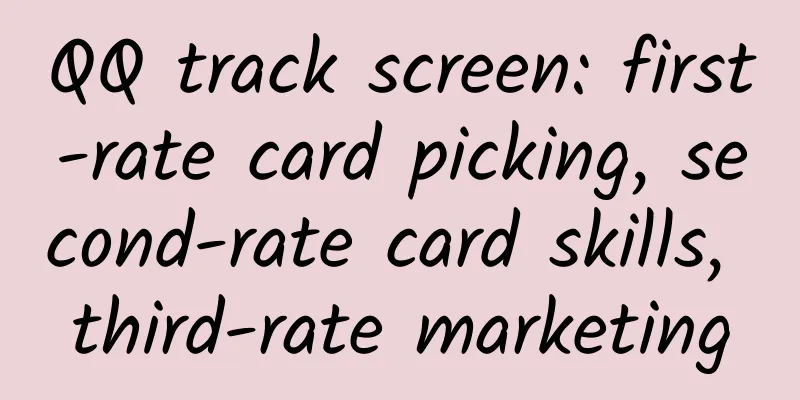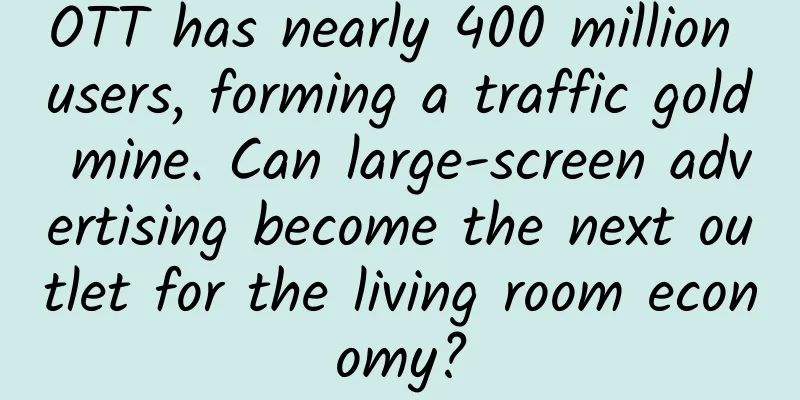QQ track screen: first-rate card picking, second-rate card skills, third-rate marketing

|
In 1999, Tencent QQ was born. In the past 20 years, this little penguin has accompanied countless people through their youth. For many people born in the 1980s and 1990s, QQ has a special feeling and memory. For many people born in the 2000s, QQ is their best social tool. With the big gimmick of 20 years, how can QQ not do something? On the evening of May 27, an H5 called "QQ Personal Tracks" was all over the WeChat Moments, attracting many people to repost and discuss. It must be said that from the starting point, this idea is great and has indeed achieved visible results. But at the same time, although the effect is good, the flaws cannot be concealed. Some flaws revealed during the specific implementation process made this marketing seem imperfect, which may be something QQ needs to pay attention to in the future. ***'s starting card: holding ***'s "social currency bank" There are too many sentimental H5 marketing, how can QQ arouse people's desire to forward this time? We won't say much nonsense about the high user base, let's just talk about something we haven't seen before. In the eyes of the Internet Jianghu team, the topic attributes and social power of social software represented by QQ are the key. From the perspective of industry characteristics, different products correspond to different industries and therefore have different industry communication power. In the opinion of the Internet Jianghu team, the social power of an industry can be judged by the following formula: Industry communication power = industry scale * enterprise scale ratio * number of social currency We usually analyze Tencent, especially BAT, which connects people with things, people with information, and people with people, to determine the business valuation and the possibility of being disrupted, but few people interpret it from a marketing perspective. In fact, from a marketing perspective, applying the above formula, the industrial social power of BAT in their respective fields is very different. The industry scales of social networking, e-commerce, and search are not comparable, so let's look at the latter two. In terms of the proportion of enterprise scale, Tencent is the only dominant player in the field of acquaintance social networking. When it comes to the feelings and topics about social software, the only ones that come to mind are Tencent's QQ and WeChat. In terms of search, Baidu has the largest market share, but search engines such as Sogou and 360 have many users and their own unique features, such as Sogou's WeChat public account search. Not to mention Alibaba, there are too many e-commerce players such as JD.com, Suning, Pinduoduo, and Vipshop. From the perspective of social currency, Li Jiaoshou, former vice president of Baidu and self-media person, once proposed the concept of "social currency". He believes that in order to get others to share, one must provide benefits to others, and social currency is the benefit point that drives users to forward. Since it is a social software, Tencent actually has its own "social currency", which not only occupies social interaction, but also occupies the user's emotions. Therefore, Tencent not only occupies the user stickiness with its business model, but also has an innate magic weapon in marketing, which is the social card. Tencent's positioning in social networking not only occupies the rigid demand traffic, but also occupies the sensitive point in marketing, which is easy to produce explosive products to stimulate user participation. Think about it from another perspective. If Baidu were to do something similar to QQ's H5, what would you search for the first time? It would be boring. If Alibaba were to do something similar, it would probably follow suit. But Tencent can use it from time to time. WeChat has used similar marketing before. This is the value of social topics, which is the easiest to impress people. Another example is NetEase Cloud Music, which has become very popular by relying on comments, a piece of social scraps, and has carved out a rough jade from the scraps. In fact, social currency can actually be replaced by [talking points]. Only with talking points can there be value in being spread. If you want marketing information to be spread by more people, it depends on whether the marketing content provides the public with talking points, and unusual events that occur in ordinary scenes. This is actually similar to Durex. Why does Durex often create marketing campaigns that go viral? Because it involves the topic of hormones, so it comes with "talking points" or "social currency". But QQ is better than Durex in that QQ creates momentum, while Durex can only take advantage of it. Durex's own marketing campaigns are awkward and often make people feel vulgar. The fact that it was criticized for co-marketing with multiple brands and even implicated Heytea is proof of this. There is no such concern in social networking. Everyone has many emotions in the process of social interaction, and different emotions correspond to different social currencies. In this way, Tencent actually holds the largest "social currency bank" in its hands, and it is easy to hit the user's emotional "G-spot" in marketing. Second-rate card skills: emotional marketing mixed with a bit of "Luo-style self-entertainment"? It has obvious inherent advantages and did dominate the screen for a while, but it must be said that the flaws of this marketing are also obvious. Seeing the title of the H5, most people can probably guess what the H5 is trying to express. But this still does not hinder their desire to browse their past. However, unlike the full of feelings and memories before watching, after watching it, they unconsciously feel a little disappointed: they haven't seen enough in the past, and the ads come too fast. A successful emotional marketing plan should be gradual, well-paced, and with proper control of emotions. From the starting point of view, QQ is very targeted in user positioning this time. Through emotional insights into the target group, it discovers their common emotional appeal - nostalgia. Then there should be a process of building up momentum, reaching the edge of a blowout, and then exploding. Only such emotional marketing will generate impulsive and even unreasonable consumption behaviors among users. But as for the QQ track H5 this time, people are obviously not satisfied after watching it. They are just a little emotionally touched, but the content stops abruptly and turns directly to the ultimate goal of commercial conversion? The scene design feels a bit anticlimactic. All marketing is for conversion, that's right. What is the essence of emotional marketing? The competition for traffic has changed from traffic to scene, and through emotional changes, users have changed from attention economy to intention economy. But now the situation of this H5 gives people the feeling that the scene is half built and the emotion has not yet exploded, so it is difficult to generate the intention economy of purchase. This can't help but make a comparison with the previous WeChat marketing. The content displayed in the last WeChat marketing included telling users the day they registered, their first Moments, their first WeChat friends, the number of Moments posted, the number of likes, the number of red envelopes sent and received, the number of friends, the number of likes, the number of WeChat steps, etc. Enough content means that enough [emotional potential energy] has been accumulated. QQ actually brings us many good memories, and there are also many marketing plans that can be made. For example, which post has the most likes and comments, and who has visited your space the most. In the past, small games such as buying and selling friends, stealing vegetables, and grabbing parking spaces can all be brought out, but now it seems a bit simpler than the previous WeChat event, which reminds people of Luo Yonghao and his Hammer phone launch conference. There is a saying that Luo Yonghao's press conference is not only a product press conference, but also a performance of Luo Yonghao's entrepreneurial sentiment. But sentiment has nothing to do with mobile phones, and the final sales results are well known. This time QQ seems to be the same, talking about sentiment and then entering the conversion interface early. Such so-called emotions may have a lot of self-entertainment. Will users really buy it? Perhaps the Hammer phone is a lesson learned from the past. In addition, speaking of sentiment, the target group seems a bit vague. It is impossible to get people who no longer use QQ to play and spend money on it. Many of the content and memories on the QQ track belong to those born in the 1980s and 1990s. We can think that this is actually a marketing campaign targeting this group of people. QQ itself is actually a social product for acquaintances. It is similar to WeChat in nature, but covers different groups of people. For many people born in the 1980s and 1990s, their acquaintances are all using WeChat. As a social product for acquaintances, QQ is difficult to attract them to come back and consume. In terms of sales conversion, even if there is a conversion, it may be relatively virtual. For people who often use QQ and have the ability to consume, consumption is a matter of time. Perhaps an advertisement in the space can trigger consumption, while those who are indifferent are likely to remain indifferent and turn around and leave after their emotional hormones are burned out. Will they buy a QQ show? Get a green diamond to add background music to the space? Really not, because they are too old. Third-rate marketing: How to correct flaws when they are discovered? Overall, the communication strength and effect of QQ Tracks' H5 marketing itself are satisfactory, but the existence of a few flaws such as the scene design, crowd positioning, and advertising placement mentioned above may affect the overall aesthetics. In the view of the Internet Jianghu team, in summary of this marketing campaign, QQ PR needs to find a marketing mindset and system that is truly suitable for its product positioning. Here, we provide a marketing growth framework for 2C products: Separation of marketing and sales First, use products to attract traffic, and then use various value-added services that come with QQ to realize value. Let marketing be marketing, and sales be sales. If you want to build a good brand and attract old users to return, you should make the emotional scenes complete. If you want to complete sales, there is no need to take so many detours, because QQ itself is a product with a strong commercial flavor. In addition, marketing is not for immediate conversion. Often it is to establish community relationships or simply maintain the brand image, and then it is possible to further build a deep community business relationship. In general, the result of sales activities is sales volume, and the result of marketing activities is deepening of connections. Brand and service stratification Traditional marketing is positive marketing (mainly promoting oneself), while Durex content marketing is reverse marketing (mainly serving users). Durex is user-centric, reversely produces content that users like, and cleverly connects popular hot events with the Durex brand with creativity, producing specific content for specific groups of people. If QQ's H5 this time first builds the brand with sentiment, adopts a strategy of casting a wide net, and does not add too many commercial elements, then identifies its target consumers, studies the mainstream values of people of their age, makes the personality of the target consumers consistent with the brand personality it wants to establish, and then conducts commercialization, this should not be a difficult task for QQ. Focus on user lifetime value When they reach a certain age, QQ users switch to WeChat? For QQ, the biggest problem should be the customer life cycle value (CLV). Traffic-based products are cost centers, focusing on CAC customer acquisition costs; value-based products are profit centers, focusing on LTV customer lifetime value, and QQ is more like a "mixture" of the two. How to make children stay when they grow up is the mission that QQ marketing should convey. Back to this H5 marketing. After watching it several times, tears welled up in my eyes and I couldn't stop them. It would be pretentious to shed tears, but it would seem something was missing if I didn't. After all, I suddenly encountered my childhood and youth. The details were so vivid, but not delicate enough, like half-boiled water, which made me whoosh a little. Of course, the above analysis of QQ may be wrong. Even if you have done nothing wrong, but being too old is a big mistake. When the good years are gone, I can no longer understand young people, and I can no longer understand QQ. Everything is just the fantasy of middle-aged greasy men. |
<<: Gartner: Apple's global smartphone market share dropped to third place in the first quarter
>>: Huawei Mate 20 Pro returns to the Android Q list
Recommend
2G is abandoned by many countries, China will have to wait at least another ten years
The GSM network, which has made a monumental cont...
What happens in the body when you have diarrhea? Why can you walk a thousand miles if you hold your urine, but you can't walk an inch if you have diarrhea?
There are always moments in life when you need to...
Don’t fall into the trap again! Common problems and strategy analysis of community operations!
What is the difference between community operatio...
Official review of "10 years of WeChat": the original interface looked like this, full of memories
WeChat was officially launched on January 21, 201...
How much does it cost to create Sogou Encyclopedia? Are there any discounts?
Everyone knows that Sogou Encyclopedia is a platf...
The mysterious setting in the Analects: The harder the life, the better the character?
Mixed Knowledge Specially designed to cure confus...
Wanshi E-commerce "Practical Experience of Douyin with No Source of Goods", how to shoot videos on Douyin without source of goods?
Wanshi e-commerce Douyin no-source practical tuto...
Highlights of APP free and paid channel promotion!
Before I did it, I had heard of various methods o...
Data analysis gives you a reason for your explosive sales
Data analysis makes your sales boom come true Cou...
Today is Sunday, but I have to go to work! Why does taking a day off make people so exhausted?
The May Day holiday is coming soon, but before th...
How to position your personality in short videos?
We have seen that many popular short video accoun...
Alibaba YunOS: Since we have caught up with the good times, let’s move forward quickly
When I saw the words “The first Alibaba Cloud OS ...
Ukraine subway becomes "air-raid shelter" for people to take shelter! Don't underestimate the civil air defense projects around you
After the Russian-Ukrainian conflict, the Kiev me...
Li Xiang: Tesla has already hit our doorstep, let’s stop making self-congratulatory propaganda about the 60-speed constant speed.
Today, Tesla launched the basic version of Model ...
8 Tips for Optimizing App Store Keyword Rankings
In terms of ASO, it is similar to SEO and has a s...









